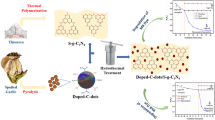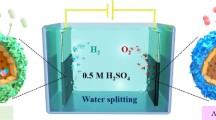Abstract
The MoS2@TiO2 hollow sphere heterostructures (MoS2@THS) were synthesized and used for photocatalytic reduction of U(VI) from wastewater under visible light. The optimum MoS2@THS-12 shows the highest photocatalytic reduction rate (irradiated for 80 min) with excellent recyclability and stability, which is approximately 4.1 times as much as the pure MoS2. The improved photocatalytic activity of MoS2@THS-12 is mainly due to the II-types heterojunction formed between MoS2 and THS. Meanwhile, the photogenerated electrons and superoxide radical are important active species in the photoreduction U(VI) process. The results provide an effective strategy for uranium resource utilization and pollution abatement.









Similar content being viewed by others
References
Wei Y, Zhang L, Shen L, Hua D (2016) Positively charged phosphonate-functionalized mesoporous silica for efficient uranium sorption from aqueous solution. J Mol Liq 221:1231–1236
Liu C, Hsu PC, Xie J, Zhao J, Wu T, Wang H, Liu W, Zhang J, Chu S, Cui Y (2017) A half-wave rectified alternating current electrochemical method for uranium extraction from seawater. Nat Energy 2:17007
Sun Q, Aguila B, Perman J, Ivanov AS, Bryantsev VS, Earl LD, Abney CW, Wojtas L, Ma S (2018) Bio-inspired nano-traps for uranium extraction from seawater and recovery from nuclear waste. Nat Comm 9:1644
Cantrell JL, Kaplan DI, Wietsma TW (1995) Zero-valent iron for the in situ remediation of selected metals in groundwater. J Hazard Mater 42:201–212
Charlet L, Silvester E, Liger E (1998) N-compound reduction and actinide immobilisation in surficial fluids by Fe(II): the surface FeIIIOFeIIOH species, as major reductant. Chem Geol 151:85–93
Noubactep C, Schöner A, Meinrath G (2006) Mechanism of uranium removal from the aqueous solution by elemental iron. J Hazard Mater 132:202–212
Salomone VN, Meichtry JM, Zampieri G, Litter MI (2015) New insights in the heterogeneous photocatalytic removal of U(VI) in aqueous solution in the presence of 2-propanol. Chem Eng J 261:27–35
Salomone VN, Meichtry JM, Litter MI (2015) Heterogeneous photocatalytic removal of U(VI) in the presence of formic acid: U(III) formation. Chem Eng J 270:28–35
Amadelli R, Maldotti A, Sostero S, Carassiti V (1991) Photodeposition of uranium oxides onto TiO2 from aqueous uranyl solutions. J Chem Soc, Faraday Trans 87:3267–3273
Odoh SO, Pan QJ, Shamov GA, Wang F, Fayek M, Schreckenbach G (2012) Theoretical study of the reduction of uranium(VI) aquo complexes on titania particles and by alcohols. Chem-Eur J 18:7117–7127
Li Z, Wang H, Yin S, Wang P, Yan B, Huang X, Wang R, Li X, Zong H, Han C (2016) Understanding the anatase–rutile phase junction in charge separation and transfer in a TiO2 electrode for photoelectrochemical water splitting. Chem Sci 7:6076–6082
Kim YK, Lee S, Ryu J, Park H (2015) Solar conversion of seawater uranium(VI) using TiO2 electrodes. Appl Catal B Environ 163:584–590
He F, Meng AY, Cheng B, Ho WK, Yu JG (2020) Enhanced photocatalytic H2-production activity of WO3/TiO2 step-scheme heterojunction by graphene modification. Chinese J Catal 41:9–20
Tayyab M, Noman Azeem M, Ashraf A (2019) Synthesis and applications of nano-TiO2: a review. Environ Sci Pollut R 26:3262–3291
Mamaghani AH, Haghighat F, Lee CS (2020) Role of titanium dioxide (TiO2) structural design/morphology in photocatalytic air purification. Appl Catal B Environ 269:118735
Miyoshi A, Nishioka S, Maeda K (2018) Water splitting on rutile TiO2-based photocatalysts. Chem-Eur J 24:18204–18219
Zhao F, Rong Y, Wan J, Hu Z, Peng Z, Wang B (2018) MoS2 quantum dots@TiO2 nanotube composites with enhanced photoexcited charge separation and high-efficiency visible-light driven photocatalysis. Nanotechnology 29:105403
Zheng L, Han S, Liu H, Yu P, Fang X (2016) Hierarchical MoS2 nanosheet@TiO2 nanotube array composites with enhanced photocatalytic and photocurrent performances. Small 12:1527–1536
He S, Zhang Y, Ren J, Wang B, Zhang M (2020) Facile synthesis of TiO2@MoS2 hollow microtubes for removal of organic pollutants in water treatment. Colloid Surface A 600:124900
Guo L, Yang Z, Marcus K, Li Z, Luo B, Zhou L, Wang X, Du Y, Yang Y (2017) MoS2/TiO2 heterostructures as nonmetal plasmonic photocatalysts for highly efficient hydrogen evolution. Energy Environ Sci 11:106–114
Yang Y, Wang S, Lin S, Li Y, Zhang W, Chao Y, Luo M, Xing Y, Wang K, Yang C, Zhou P, Zhang Y, Tang Z, Guo S (2018) Rational design of hierarchical TiO2/ epitaxially aligned MoS2-carbon coupled interface nanosheets core/shell architecture for ultrastable sodium-ion and lithium-sulfur batteries. Small Methods 2:1800119
Zhou WJ, Yin ZY, Du YP, Huang X, Zeng ZY, Fan ZX, Liu H, Wang JY, Zhang H (2013) Synthesis of few-layer MoS2 nanosheet-coated TiO2 nanobelt heterostructures for enhanced photocatalytic activities. Small 9:140–147
Feng Z, Yu Z, Song S, Zhang H (2011) Superior electrode performance of mesoporous hollow TiO2 microspheres through efficient hierarchical nanostructures. J Power Sources 196:8618–8624
Zhu M, Cai Y, Liu S, Fang M, Tan X, Liu X (2019) K2Ti6O13 hybridized graphene oxide: effective enhancement in photodegradation of RhB and photoreduction of U(VI). Environ Pollut 248:448–455
Wu L, Wan G, Hu N, He Z, Shi S, Suo Y (2018) Synthesis of porous CoFe2O4 and its application as a peroxidase mimetic for colorimetric detection of H2O2 and organic pollutant degradation. Nanomaterials 8:451
Qu Y, Zhang D, Wang X, Qiu H, Zhang T, Zhang M, Tian G, Yue H, Feng S, Chen G (2017) Porous ZnFe2O nanospheres as anode materials for Li-ion battery with high performance. J Alloy Compd 721:697–704
Beiler AM, Mccarthy BD, Johnson BA, Ott S (2020) Enhancing photovoltages at p-type semiconductors through a redox-active metal-organic framework surface coating. Nat Comm 11:5819
Li Y, Wang H, Xie L, Liang Y, Hong G, Dai H (2011) MoS2 nanoparticles grown on graphene: an advanced catalyst for the hydrogen evolution reaction. J Am Chem Soc 133:7296
Yu L, Xie YL, Zhou JQ, Li Y, Yu Y, Ren ZF (2018) Robust and selective electrochemical reductionof CO2: the case of integrated 3D TiO2@MoS2 architectures and Ti-S bonding effects. J Mater Chem A 6:4706–4713
Cravanzola S, Sarro M, Cesano F, Calza P, Scarano D (2018) Few-layer MoS2 nanodomains decorating TiO2 nanoparticles: a case study for the photodegradation of carbamazepine. Nanomaterials 8:207
Zhang Y, Zhu M, Zhang S, Cai Y, Wang X (2020) Highly efficient removal of U(VI) by the photoreduction of SnO2/CdCO3/CdS nanocomposite under visible light irradiation. Appl Catal B Environ 279:119390
Gong J, Xie Z, Wang B, Li Z, Le Z (2020) Fabrication of g-C3N4-based conjugated copolymers for efficient photocatalytic reduction of U(VI). J Environ Chem Eng 9:104638
Zhang Z, Liu C, Dong Z, Dai Y, Xiong G, Liu Y (2020) Synthesis of flower-like MoS2/g-C3N4 nanosheet heterojunctions with enhanced photocatalytic reduction activity of uranium(VI). Appl Surf Sci 520:146352
Chen K, Chen CL, Ren XM, Alsaedi A, Hayat T (2019) Interaction mechanism between different facet TiO2 and U(VI): experimental and density-functional theory investigation. Chem Eng J 359:944–954
Jiang XH, Xing QJ, Luo XB, Li F, Zou JP, Liu SS, Li X, Wang XK (2018) Simultaneous photoreduction of uranium(VI) and photooxidation of Arsenic(III) in aqueous solution over g-C3N4/TiO2 heterostructured catalysts under simulated sunlight irradiation. Appl Catal B Environ 228:29–38
Wang Z, Liu H, Lei Z, Huang L, Wu T, Liu S, Ye G, Lu Y, Wang X (2020) Graphene aerogel for photocatalysis-assist uranium elimination under visible light and air atmosphere. Chem Eng J 402:126256
Liu X, Du P, Pan W, Dang C, Qian T, Liu H, Liu W, Zhao D (2019) Immobilization of uranium(VI) by niobate/titanate nanoflakes heterojunction through combined adsorption and solar-light-driven photocatalytic reduction. Appl Catal B Environ 231:11–22
Dong ZM, Zhang ZB, Li ZF, Feng Y, Dong WJ, Wang T, Cheng ZP, Wang YQ, Dai Y, Cao XH, Liu YH, Liu YH (2021) 3D structure aerogels constructed by reduced graphene oxide and hollow TiO2 spheres for efficient visible-light-driven photoreduction of U(VI) in air-equilibrated wastewater. Environ Sci Nano 8:2372–2385
Sun YB, Li JX, Wang XK (2014) The retention of uranium and europium onto sepiolite investigated by macroscopic, spectroscopic and modeling techniques. Geochim Cosmochim Ac 140:621–643
Cheng L, Zhang S, Wang Y, Ding G, Jiao Z (2016) Ternary P25-graphene-Fe3O4 nanocomposite as a magnetically recyclable hybrid for photodegradation of dyes. Mater Res Bull 73:77–83
Li P, Wu H, Liang J, Yin Z, Pan D, Fan Q, Xu D, Wu W (2017) Sorption of Eu(III) at feldspar/water interface: effects of pH, organic matter, counter ions, and temperature. Radiochim Acta 105:1049–1058
Wang JJ, He BH, Wei XY, Li P, Liang JJ, Qiang SR, Fan QH, Wu WS (2019) Sorption of uranyl ions on TiO2: effects of pH, contact time, ionic strength, temperature and HA. J Environ Sci 75:115–123
Wang Z, Zhang J, Lv J, Dai K, Liang C (2017) Plasmonic Ag2MoO4/AgBr/Ag composite: excellent photocatalytic performance and possible photocatalytic mechanism. Appl Surf Sci 396:791–798
Wang Z, Wang K, Li Y, Jiang L, Zhang G (2019) Novel BiSbO4/BiOBr nanoarchitecture with enhanced visible-light driven photocatalytic performance: Oxygen-induced pathway of activation and mechanism unveiling. Appl Surf Sci 498:143850
Xu D, Shi W, Song C, Chen M, Yang S, Fan W, Chen B (2016) In-situ synthesis and enhanced photocatalytic activity of visible-light-driven plasmonic Ag/AgCl/NaTaO3 nanocubes photocatalysts. Appl Catal B Environ 191:228–234
Su F, Li PP, Huang JS, Gu MJ, Liu ZY, Xu YH (2021) Photocatalytic degradation of organic dye and tetracycline by ternary Ag2O/AgBr–CeO2 photocatalyst under visible-light irradiation. Sci Rep 11:85
Xu F, Meng K, Cheng B, Wang S, Yu J (2020) Unique S-scheme heterojunctions in self-assembled TiO2/CsPbBr 3 hybrids for CO2 photoreduction. Nat Comm 11:4613
Liu H, Zhai H, Hu C, Yang J, Liu Z (2017) Hydrothermal synthesis of In2O3 nanoparticles hybrid twins hexagonal disk ZnO heterostructures for enhanced photocatalytic activities and stability. Nanoscale Res Lett 12:466
He H, Lin J, Fu W, Wang X, Wang H, Zeng Q, Gu Q, Li Y, Yan C, Tay BK, Xue C, Hu X, Pantelides ST, Zhou W, Liu Z (2016) MoS2/TiO2 edge-on heterostructure for efficient photocatalytic hydrogen evolution. Adv Energy Mater 6:1600464
Liu X, Du P, Pan W (2018) Immobilization of uranium(VI) by niobate/titanate nanoflakes heterojunction through combined adsorption and solar-light-driven photocatalytic reduction. Appl Catal B Environ 231:11–12
Vomiero MA (2019) Advanced electrocatalysts for hydrogen evolution reaction based on core-shell MoS2/TiO2 nanostructures in acidic and alkaline media. ACS Appl Ener Mat 2:2053–2062
Shen XF, Zhang Y, Shi Z, Shan SD, Liu JS, Zhang LS (2021) Construction of C3N4/CdS nanojunctions on carbon fiber cloth as a filter-membrane-shaped photocatalyst for degrading flowing wastewater. J Alloy Compds 851:156743
Pan JQ, Li HL, Li S, Ou W, Liu YY, Wang JJ, Song CS, Zheng YY, Li CR (2020) The enhanced photocatalytic hydrogen production of nickel-cobaltbimetals sulfide synergistic modified CdS nanorods with active facets. Renew Energy 156:469–477
Wang R, Shi M, Xu F, Qiu Y, Zhang Y (2020) Graphdiyne-modified TiO2 nanofibers with osteoinductive and enhanced photocatalytic antibacterial activities to prevent implant infection. Nat Comm 11:4465
Dong ZM, Zhang ZB, Zhou RZ, Dong YY, Dai Y, Cao XH, Wang YQ, Liu YH (2020) Construction of oxidized millimeter-sized hierarchically porous carbon sphere for U(VI) adsorption. Chem Eng J 386:123944
Acknowledgements
The authors would like to thank State Administration of Science. Technology and Industry for National Defense, China for funding this work under the [2014]1587 Grant, and the School of Geosciences, East China University of Technology for providing geology and mechanics data in the Tamusu pre-selected area for geological disposal of HLW.
Author information
Authors and Affiliations
Corresponding author
Additional information
Publisher's Note
Springer Nature remains neutral with regard to jurisdictional claims in published maps and institutional affiliations.
Rights and permissions
About this article
Cite this article
Rao, G., Liu, X. & Liu, P. Fabrication of MoS2@TiO2 hollow‐sphere heterostructures with enhanced visible light photocatalytic reduction of U(VI). J Radioanal Nucl Chem 331, 263–273 (2022). https://doi.org/10.1007/s10967-021-08091-2
Received:
Accepted:
Published:
Issue Date:
DOI: https://doi.org/10.1007/s10967-021-08091-2




